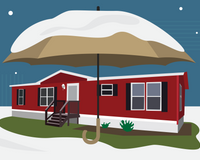Frozen or burst pipes. Bone-chilling drafts. Astronomical energy bills. Any of these things can happen if you don’t know how to winterize your mobile home. Winterizing a mobile home has three primary objectives:
By ensuring your mobile home is properly sealed and insulated from top to bottom, you can spare yourself a lot of headaches down the road. Better yet, you can tackle many of the simpler tasks yourself without great expense.
Insulating and sealing the roof and ceiling
Warm air rises — and if there are gaps or leaks between your ceiling and roof, it might just rise right out of those breaches into the outside. There are several areas you’ll want to pay attention to up top, including seams and expansion joints (especially in metal roofs), vents, stacks, and the TV antenna wire entrance. Polyurethane caulk, expandable foam, butyl tape, and roof sealants and coatings are among the products typically used to weatherproof mobile home roofs. At Star Mobile Home Supplies, we like Eternabond Roof & Leak Repair Tape.
Next, you’ll want to investigate the status of your ceiling insulation. Many times the space between the ceiling and roof is under-insulated, so additional insulation will need to be blown in. There are three common ways of doing this:
- From within the home through the ceiling (interior blow)
- From the edges, by “lifting the lid” or propping up the roof in sections (edge blow)
-
From the top of the roof, pumping the insulation down in (ridge blow)
A more dramatic solution would be to add a sloped roof, which creates a larger cavity for insulation.
As long as you’ve got your ladder out, you should definitely clean out your gutters and downspouts. They can sag under the weight of ice and debris, which may end up causing damage to your home.
Airtight mobile home windows, doors, and walls
Leaky window and door frames can rapidly bleed your home of energy, so make sure they’re airtight and watertight before hunkering down for the cold months. Caulk or weatherstrip around frames, add storm windows or doors to shield from the elements, or invest in double-glazed windows. These windows contain an insulating layer of inert gas between two glass panes, which greatly improves thermal performance. A more inexpensive option is window film, a thin polyester material that reduces radiant energy transfer and screens out UV rays.
Other leaks may be less obvious. Check seams for drafts emanating from seams or wall strips, in corners, or places where ductwork, plumbing, or wiring passes through.
Ensure mobile home skirting and underbelly are intact
The biggest potential issues this winter may be lurking beneath your feet. Start by addressing the underbelly — this sheeting material, also known as bottom board, shields insulation and floor joists from ground moisture and prevents critters from taking up residence under your floor. If the underbelly is compromised, take the opportunity to seal and caulk the exposed ductwork, replace insulation, and tighten it all up with a new bottom board. Pairing with a ground vapor barrier (laid directly over the ground) will help keep things extra dry throughout the winter.
The next order of business is your mobile home skirting — any panels missing or damaged? Without this crucial perimeter protection, winter’s fierce winds and frosty air can freely terrorize your foundation, wiring, pipes, and ductwork. Missing skirting makes it a lot easier for the aforementioned critters to move in as well.
While you’re crouched down, do not forget to loosen tie-downs by a couple inches — the ground will contract as it freezes and place strain on your mobile home chassis and joists.
Prepping mobile home plumbing and HVAC for the cold
Preventing frozen pipes
There are few things worse than a frozen or burst pipe in the dead of winter. To prevent this from happening, you can either address the pipes themselves or what’s around them. If you have copper piping in your mobile home, you might consider replacing it with PVC (plastic) piping, which is more freeze-resistant. For additional peace of mind, you can apply rubber or fiberglass insulation pipe wraps and/or mobile home heat tape.
Of course, if you are leaving your mobile home uninhabited for an extended period during the winter, you should drain the water from your plumbing system, including the mobile water heater, completely.
Keeping furnace operating efficiently
Your mobile home furnace shoulders a pretty big responsibility throughout the winter in keeping everyone and everything inside nice and warm. Routine maintenance will make its job much easier and ensure its dependability for years to come. Replace disposable filters or clean permanent ones. Vacuum dust and dirt from the thermostat, clear obstructions and buildup from intake and exhaust vents. Make sure the furnace cabinet is clear of flammable items and the flue assembly is straight and intact. It’s a good idea to have this professionally inspected.
Winterize with Star Supply
Fall is the perfect time of year to not only winterize, but fit in all your last minute mobile home improvement projects. For high-quality products for all your maintenance and replacement needs, Star Mobile Home Supply has you covered.






